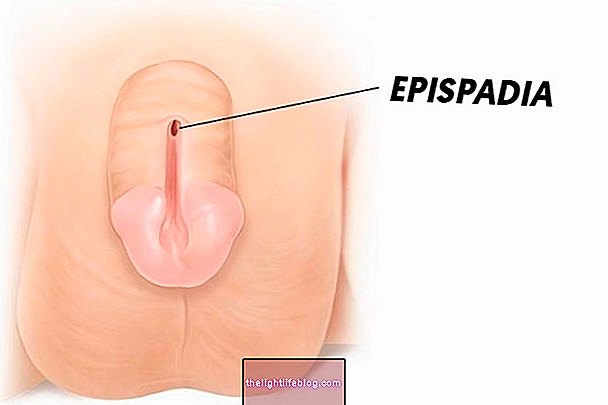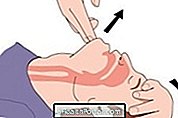Rhabdomyolysis is a serious condition characterized by the destruction of muscle fibers, which leads to the release of components present within muscle cells into the bloodstream, such as calcium, sodium and potassium, myoglobin, creatinophosphokinase and the enzyme pyruvic transaminase (TGP). Large amounts of these substances in the blood can result in lack of strength, decreased urine, muscle fatigue and kidney failure, if not identified and treated.
As the released substances are toxic in high quantities, it is important that treatment is started as soon as possible, and it is recommended to go to the hospital or emergency room as soon as rhabdomyolysis is suspected. Rhabdomyolysis can happen due to the practice of strenuous and prolonged physical activities or as a result of direct or indirect trauma to a muscle in the body, and it is also important to identify the cause so that the treatment is more targeted.

Main symptoms
Symptoms of rhabdomyolysis can vary according to the circulating amount of enzymes released from the inside of muscle cells, the most common symptoms being:
- Muscle pain;
- Lack of strength;
- Difficulty moving your legs or arms;
- Muscle stiffness;
- Joint pain;
- Urine in small quantities and very dark, similar to the color of coca-cola.
In addition to these symptoms, more general signs may appear, such as fever, nausea, abdominal pain, feeling of general tiredness, vomiting, confusion and agitation. Since the symptoms vary according to the cause, as well as the body of each person, it can be quite difficult to identify a case of rhabdomyolysis.
Therefore, in order for rhabdomyolysis to be identified and complications to be prevented, it is important to go to the hospital for specific tests to identify the disease, so that it is possible to start the most appropriate treatment.
How to confirm the diagnosis
The diagnosis of rhabdomyolysis is usually made by the doctor after assessing the person's symptoms and medical history. In addition, the doctor recommends performing blood and urine tests to check the amount of electrolytes circulating in the blood, as well as the concentration of myoglobin, creatine phosphokinase and TGP. Through urinalysis, the doctor can also assess the amount of myoglobin, which is important to know the extent of rhabdomyolysis and if there are signs indicating renal failure.
Myoglobin is one of the main exams requested by the doctor, because the greater the destruction of muscle fibers, the greater the amount of myoglobin is released into the blood and urine, leaving it quite dark. In addition, the greater the amount of myoglobin released, the greater the chance of obstruction of the renal tubules, which may result in tubular injury and, consequently, acute renal failure. Learn more about myoglobin.

What causes rhabdomyolysis
Rhabdomyolysis usually happens due to the practice of strenuous and prolonged physical activity, which results in excessive muscle stress. Other causes of rhabdomyolysis are:
- Serious accidents, such as falls from a height or traffic accident;
- Prolonged use of some medications, especially antipsychotics or statins;
- Use of drugs, mainly cocaine, heroin or amphetamines;
- Prolonged immobilization due to fainting or illness;
- Infections, which can lead to the accumulation of toxins in the body, which is the main cause of rhabdomyolysis in children;
- Muscle diseases, such as myopathy and polio;
- Change in body temperature.
In addition, rhabdomyolysis can also happen as a consequence of excessive consumption of alcoholic beverages, electric shock, metabolic diseases and stroke.
How the treatment is done
When rhabdomyolysis has no complications, it usually resolves within a few days to weeks. However, in some cases it may be necessary for treatment to be carried out with the person admitted to the hospital so that serum is administered directly into the vein to avoid serious complications of the disease, such as dehydration or kidney failure, caused by excess muscle waste in the blood.
In addition, it is important to identify the cause of rhabdomyolysis to initiate appropriate treatment, if necessary. Thus, if it is being caused by the use of any medication, for example, you should stop taking it and switch to another medication according to medical advice.
The duration of treatment varies according to the cause and the evolution of the patient, and during hospitalization it is necessary to be cuffed to assess the amount of urine per day and do other kidney tests to ensure that kidney function is not being affected. The patient is usually discharged when the tests are normal and there is no risk of developing kidney failure.
In the most severe cases, in which the kidneys start producing little urine, the doctor may prescribe dialysis to help kidney function, eliminating excess substances from the blood that may be making treatment difficult.
Possible complications
The most serious and common complication of rhabdomyolysis is the appearance of kidney damage, which can end up causing kidney failure. However, the presence of residues in the blood also leads to an increase in the levels of potassium and phosphorus in the body, which can end up affecting the functioning of the heart.
In rarer situations, another syndrome known as compartment syndrome may also arise, in which blood circulation is compromised in a region of the body, such as legs, arms or some muscles of the abdomen, causing tissue death. Understand what compartment syndrome is.
Was this information helpful?
Yes No
Your opinion is important! Write here how we can improve our text:
Any questions? Click here to be answered.
Email in which you want to receive a reply:
Check the confirmation email we sent you.
Your name:
Reason for visit:
--- Choose your reason --- DiseaseLive betterHelp another personGain knowledge
Are you a health professional?
NoMedicalPharmaceuticalsNurseNutritionistBiomedicalPhysiotherapistBeauticianOther
Bibliography
- BRAZILIAN SOCIETY OF SPORT ARTHROSCOPY AND TRAUMATOLOGY. Rhabdomyolysis. Available in: . Accessed on 02 Aug 2019
- ROSA, Nuno G. et al. Rhabdomyolysis. Acta Méd Port. Vol 18. 271-282, 2005
- MONIZ, Marta S. et al. Rhabdomyolysis as a manifestation of a metabolic disease: case report. Rev Bras Ter Intensiva. Vol 29. 1 ed; 111-114, 2017
- QUALITY MAGAZINE HC. Rhabdomyolysis. Available in: . Accessed on Dec 26, 2019























